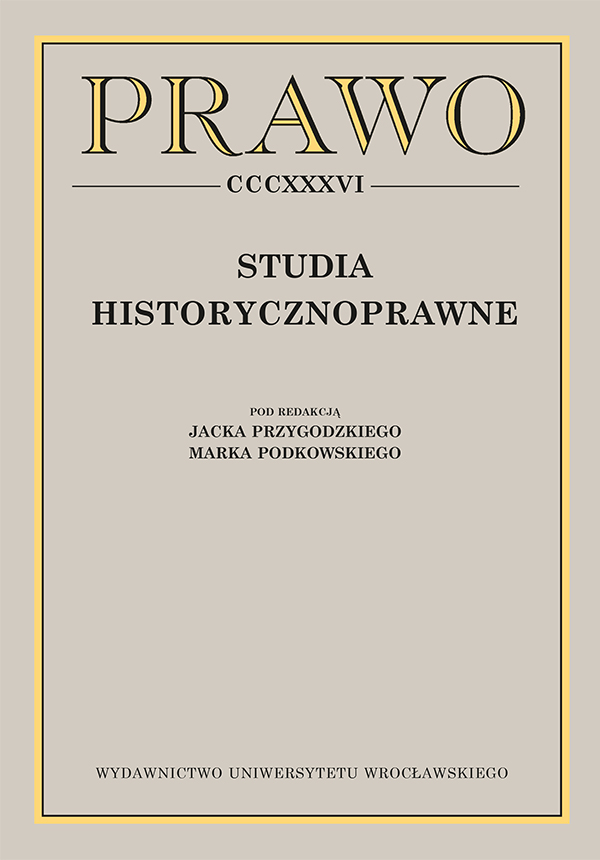

Artykuły

The Code of King Christian V (Danske Lov) issued in 1683 definitively abolished the previous particularism, introducing unity of law throughout the Danish monarchy. Many historians argue that the creation of the DL represented the greatest and most permanent work of the absolute Danish monarchy, introduced at the beginning of the second half of the 17th century. Until then, Denmark had no uniform law, which was getting increasingly burdensome. For this reason, King Frederick III, when implementing the actual changes to the political system and establishing the new legal principles for the organisation of the state, was forced to make efforts to transform the existing judicial law, limiting in particular the privileged positions of the nobility in this area. The DL was based almost exclusively on the domestic legal tradition, although in isolated cases it is possible to speak of borrowings from foreign laws, including Swedish, Norwegian, German, French, and Roman law. The DL was therefore an excellent basis for the further development of Danish law. Furthermore, its value can be evidenced by the fact that most of its provisions remained in force for roughly 200 years and a number of them remain in force today and are applied by Danish courts. In many respects, King Christian V’s Danish Code was ahead of its time, introducing principles that were not popularised in Europe until the codifications of the Age of Enlightenment. The unification of law throughout the state, the pursuit of comprehensiveness (hence, inter alia, the high regard in which the DL was held by the founder of the modern concept of codification, Jeremiah Bentham), the break with the relics of statehood in criminal law and the adoption of the principle of equality of all before the law, the guarantee of personal liberty to the Danes, its humanitarian character in comparison with other laws of the time, and the considerable shortening and acceleration of procedural proceedings constitute only some of the features of this outstanding monument to Danish legal thought. A point that is often made is that the DL was drafted in simple, clear language that everyone could understand, so that everyone could read it without difficulty. This made the applicable law more accessible, providing an additional guarantee of legal security.
The interest in and high approval of the Code, also outside Denmark, can be evidenced by attempts to use some of its provisions as models for the development of domestic law, including in Russia, Prussia, and Poland.
Bruun Chr., Enevaeldens Indførelse i Danmark og Kongelovens Tilblivelse, København 1887.
Bruun Chr., Et Bidrag til den rette Forstaaelse af Enevaeldens Indførelse i Danmark 1660, „Historisk Tidsskrift” 5, 1880–1881, 2, s. 635–700.
Czapliński W., Dzieje Danii nowożytnej (1500–1975), Warszawa 1982.
Danmarks Historie, red. J. Danstrup, H. Koch, t. 8, oprac. G. Olsen, København 1964.
Dansk Biografisk Lexikon, wyd. C.F. Bricka, t. 10, København 1898.
Dansk Biografisk Lexikon, wyd. C.F. Bricka, t. 15, København 1901.
Dansk Biografisk Lexikon, wyd. C.F. Bricka, t. 19, København 1905.
Degn O., Stænder og socialgrupper i Danske Lov, [w:] Danske og Norske Lov i 300 år, red. D. Tamm, København 1983, s. 35–63.
Fenger O., Romeret o Norden, København 1974.
Forarbejderne til Kong Krystian V. s Danske Lov, wyd. V.A. Secher, Ch. Stöchel, t. 1–2, København 1891–1894.
Fridericia J.A., Adelsvaeldens sidste dage, København 1894.
Fridericia J.A., Frederik III og Enevaeldens Indførelse, „Historisk Tidsskrift” 5, 1886–1887, 6, z. 5, s. 715–817.
Gaca A., Danske Lov i Polen. Et rids af problemstillingen, [w:] Danske og Norske Lov i 300 år, red. D. Tamm, København 1983, s. 405–416.
Gaca A., Kodeks Duński króla Chrystiana V z roku 1683, Toruń 1992.
Gaca A., Jagielski A., Wprowadzenie absolutyzmu w Danii i wydanie „Prawa królewskiego” (Kongeloven) w roku 1665 „Czasopismo Prawno-Historyczne” 51, 1999, s. 431–443.
Holtze F., Kőning Christian’s V Dänisches Gesetz als Vorbild für die preussische Justizreform 1713, Schriften Vereins für die Geschichte Berlins, Berlin 1893, z. 30.
Iuul S., Forelaesninger over Hovedlinier i Europaeisk Retsudvikling fra Romeretten til Nutiden, København 1970.
Iuul S., Kodifikation eller Kompilation? Christian V’s Danske Lov paa baggrund af aeldre Ret, København 1954.
Juristforbundets Lovsamling, red. E. Harboe-Jepsena, København 1973.
Kong Christian den Femtis Danske Lov, wyd. V.A. Secher, København 1878 (wznowienie 1891).
Kong Christian den Femtis Danske Lov, wyd. V.A. Secher, København 1911 (reprint: 1929, 1934).
Kong Christian den V’s Danske Lov af 15 april 1683, wyd. S. Iuul, København 1949.
Kongeloven, [w:] Danske Forfatningslove 1665–1953, wyd. J. Himmelstrup, J. Moller, København 1970, s. 61–72.
Latkin V.L., Zakonodatelnye kommissii v Rosii v XVIII stoletii, Petersburg 1887.
Petersen C., Anvåndningen av dansk och svensk rått i Peter den stores lagkommission, 1720–1725, [w:] Danske og Norske Lov i 300 år, red. D. Tamm, København 1983, s. 369–404. Petersen E.L., Frastandssamfund til rangs samfund, København 1980.
Saanske og Jyske Lov, wyd. E. Kroman, S. Iuul, København 1956.
Schultz Danmarkshistorie, t. 3, København 1949.
Tamm D., Hvilke bestemmelser i Danske og Norske Lov er endnu gaeldende, [w:] Danske og Norske Lov i 300 år, red. D. Tamm, København 1983, s. 303–321,
Wagner W., Danske Lov og dansk lovgivning i europæisk ramme, [w:] Danske og Norske Lov i 300 år, red. D. Tamm, København 1983, s. 207–254.